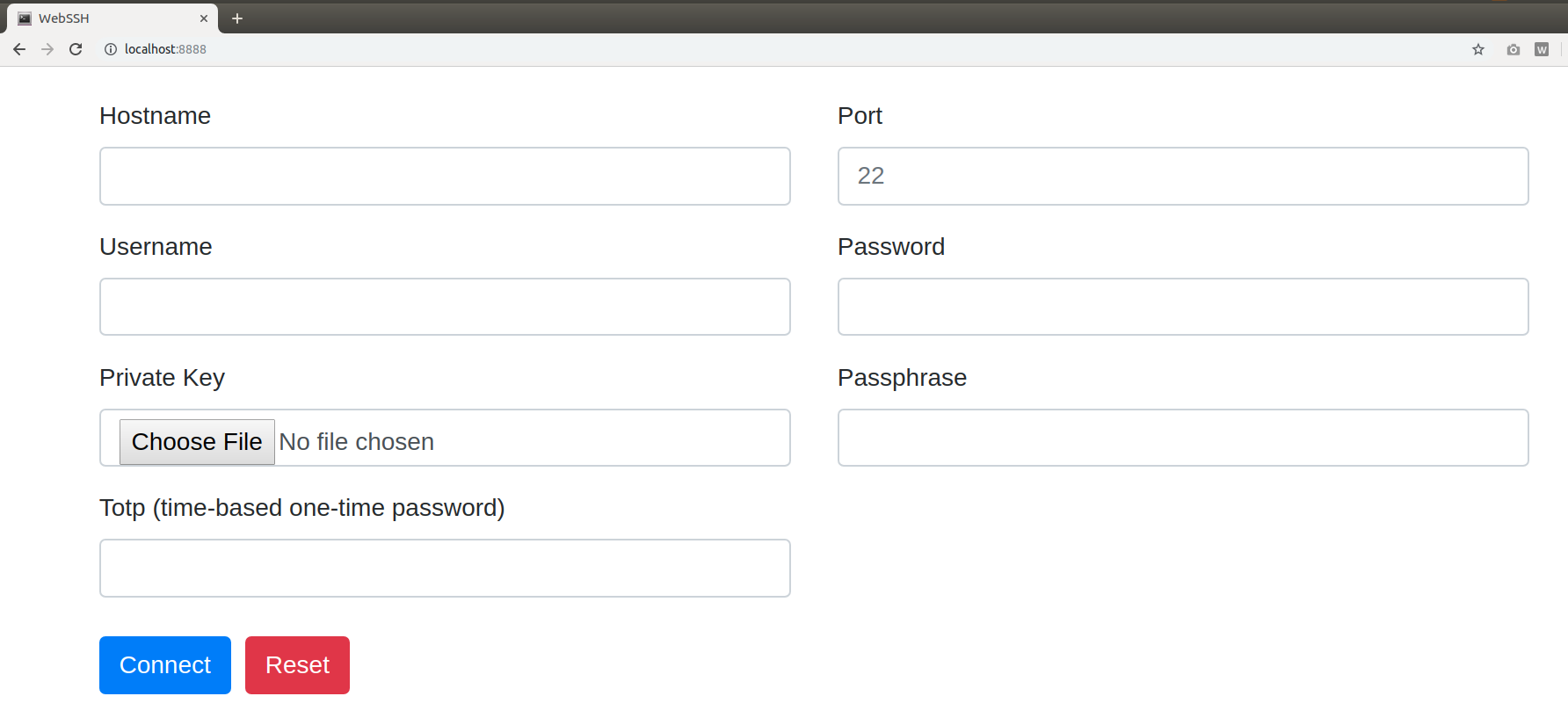Web based ssh client
Project description
WebSSH
Introduction
A simple web application to be used as an ssh client to connect to your ssh servers. It is written in Python, base on tornado, paramiko and xterm.js.
Features
SSH password authentication supported, including empty password.
SSH public-key authentication supported, including DSA RSA ECDSA Ed25519 keys.
Encrypted keys supported.
Fullscreen terminal supported.
Terminal window resizable.
Auto detect the ssh server’s default encoding.
Modern browsers including Chrome, Firefox, Safari, Edge, Opera supported.
Preview

How it works
+---------+ http +--------+ ssh +-----------+ | browser | <==========> | webssh | <=======> | ssh server| +---------+ websocket +--------+ ssh +-----------+
Requirements
Python 2.7/3.4+
Quickstart
Install this app, run command pip install webssh
Start a webserver, run command wssh
Open your browser, navigate to 127.0.0.1:8888
Input your data, submit the form.
Server options
# start a http server with specified listen address and listen port
wssh --address='2.2.2.2' --port=8000
# start a https server, certfile and keyfile must be passed
wssh --certfile='/path/to/cert.crt' --keyfile='/path/to/cert.key'
# missing host key policy
wssh --policy=reject
# logging level
wssh --logging=debug
# log to file
wssh --log-file-prefix=main.log
# more options
wssh --helpUse console
// connect to your ssh server
wssh.connect(hostname, port, username, password, privatekey);
// pass an object to wssh.connect
var opts = {
hostname: 'hostname',
port: 'port',
username: 'username',
password: 'password',
privatekey: 'the private key text'
};
wssh.connect(opts);
// without an argument, wssh will use the form data to connect
wssh.connect();
// set a new encoding for client to use
wssh.set_encoding(encoding);
// reset encoding to use the default one
wssh.reset_encoding();
// send a command to the server
wssh.send('ls -l');Tests
Use unittest to run all tests
python -m unittest discover tests
Use pytest to run all tests
python -m pytest tests
Deployment
Running behind an Nginx server
wssh --address='127.0.0.1' --port=8888 --policy=reject# Nginx config example
location / {
proxy_pass http://127.0.0.1:8888;
proxy_http_version 1.1;
proxy_read_timeout 300;
proxy_set_header Upgrade $http_upgrade;
proxy_set_header Connection "upgrade";
proxy_set_header Host $http_host;
proxy_set_header X-Real-IP $remote_addr;
proxy_set_header X-Real-PORT $remote_port;
}Running as a standalone server
wssh --port=8080 --sslport=4433 --certfile='cert.crt' --keyfile='cert.key' --xheaders=False --policy=rejectTips
For whatever deployment choice you choose, don’t forget to enable SSL.
If you choose running this app as a standalone server, redirecting http to https is enabled by default, and only http requests from a public network will be redirected.
Try to use reject policy as the missing host key policy along with your verified known_hosts, this will prevent man-in-the-middle attacks. The idea is that it checks the system host keys file(“~/.ssh/known_hosts”) and the application host keys file(“./known_hosts”) in order, if the ssh server’s hostname is not found or the key is not matched, the connection will be aborted.
Project details
Release history Release notifications | RSS feed
Download files
Download the file for your platform. If you're not sure which to choose, learn more about installing packages.
















